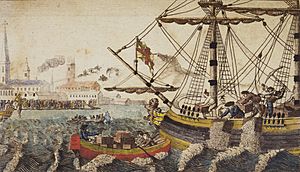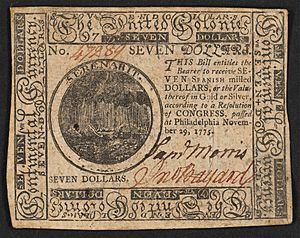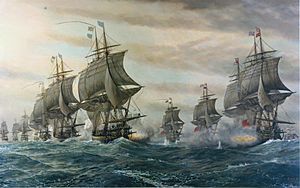Financial costs of the American Revolutionary War facts for kids
The American Revolutionary War cost a lot of money for everyone involved. This included the United States, France, Spain, and Great Britain. France spent 1.3 billion livres, and Great Britain spent 250 million pounds. The United States paid $400 million to its soldiers. Spain's military spending almost doubled from 1778 to 1781.
Contents
How the War Was Paid For
Early Economic Fights

Economic fights between Great Britain and the American colonists started before the colonies declared independence in 1776. The British government made rules that the colonists did not like. When talking and asking for changes did not work, the colonists stopped buying British goods. This was called a boycott.
Boycotts worked well to hurt British trade. After the first boycott in 1765, Britain removed the Sugar and Stamp Acts. After a second boycott in 1768, Britain removed most of the Townshend duties. Only the tax on tea remained. The colonists kept protesting. This led to the Boston Tea Party in 1773. Even though the Revolution is linked to colonists hating high taxes, some say colonists actually paid much less tax than people in Britain.
Britain's Plan to Stop Trade
Britain tried to weaken the colonies by cutting off their trade with the rest of the world. Britain had a much stronger navy than America. This gave Britain control over American ports. British warships took over major port cities along the East Coast. This greatly reduced the number of ships that could travel from the colonies.
Because of this strong British blockade, the U.S. exported fewer goods. Britain's navy was also strong enough to scare other nations. They were afraid to export goods to the colonies. This made smuggled and cheap imports become expensive and rare.
How the War Affected Britain
France had a powerful navy. When France joined the war, it weakened Britain's blockade on colonial ports. It also cut off supplies for the British army coming from the Atlantic Ocean. British forces knew they could not last long without supplies.
So, Britain sent some of its forces to the French Caribbean. They hoped to capture French sugar islands. This would cut off France's money supply. This new war in the Caribbean added to Britain's already high costs. Unlike the colonies, Britain could not get loans or weapons from other countries. Without help, the financial stress on Britain grew. This helped wear down the British forces and end the war.
America's Money Troubles
As the war went on, America's money problems became a big advantage for Britain. The Continental Congress could not tax the colonists. So, it printed money very quickly to pay the army and its foreign loans. This caused prices to rise very fast, and the Continental dollar lost its value.
The colonists also had trouble paying for the war against Britain's southern campaign. They could not stop the British until the Battle of Yorktown in 1781. When the war ended in 1783, America worked to pay off its national debt. They did this through talks, money policies, and changing the government.
Who Paid What?
The United States' Costs
At the start of the war, the thirteen American states did well economically. The colonies could trade freely with the West Indies and other European nations. Before, they could only trade with Britain. The British Navigation Acts were removed. This meant American merchants could use European and American ships, not just British ones.
British taxes on expensive items like tea, glass, and paper were gone. Other taxes became cheaper. Also, American privateers attacked British merchant ships. This brought more money to the Continental Army.

As the war continued, America's economy got worse. British warships started attacking American ships. The Continental Army also cost more and more to keep going. This meant less money from merchant ships. As money ran out, the United States had to rely on loans from Europe. France, Spain, and the Netherlands lent the U.S. over $10 million during the war. This caused big debt problems for the new country.
There was also less coin money. Because of this, the United States started printing paper money and credit bills to get income. This did not work well. Prices went way up, and the new paper money became almost worthless. People had a saying: anything of little value was "not worth a continental."
Money Problems and Inflation
By 1780, the United States Congress had printed over $400 million in paper money for its soldiers. Congress tried to stop the rising prices by making economic changes. These failed and made American money even less valuable. There is some debate about how much money was actually printed.
Between 1775 and 1783, prices in the colonies went up by about 4.3% each year. The highest price increase was almost 30% in 1778. Many food riots happened as people became unhappy about quickly rising prices. Damaged property and Congress printing more money also made the currency lose value. Also, the British Government made fake American dollars on purpose to hurt the war effort.
Late in the war, Congress asked each colony to equip its own troops. They also asked them to pay for their own soldiers in the Continental Army. When the war ended, the United States had spent $37 million at the national level. States had spent $114 million. The United States finally solved its debt problems in the 1790s. This happened when Alexander Hamilton started the First Bank of the United States. This bank helped pay off war debts and create good national credit.
Great Britain's Costs
The American Revolutionary War was very expensive for Great Britain. The war cost about £12 million each year. When the war ended, Britain had a national debt of £250 million. This debt cost over £9.5 million in interest each year.
This debt was added to money Britain already owed from the Seven Years' War. That war had increased Britain's debt from £73 million in 1755 to £137 million in 1763. Paying off this old debt cost £5 million a year. At the time, the government only made £8 million in income. This meant over 60% of the budget went to debt in some years during the 1760s. This is why Parliament wanted Americans to pay for 7,500 soldiers to be in the Colonies. They thought it was fair because British taxpayers paid much more than Americans during the Seven Years' War.
Taxes on British people went up during the war years (1776-1783). New taxes were added on items like glass and lead. The average tax for British people was four shillings for every pound (20 percent). Also, the Royal Navy was not as strong as it had been in the Seven Years' War.
Great Britain's trade with the thirteen American colonies stopped when the American Revolution began. This hurt British businesses, especially those in the tobacco industry. Money from selling wool and metal products dropped sharply. Export markets disappeared. British merchant sailors also suffered. It is thought that 3,386 British merchant ships were captured by enemy forces during the war. However, Royal Navy warships made up for some of these losses. They captured enemy ships, especially Spanish and French merchant ships.
France's Costs
France also faced a huge financial burden during the war. Debt from the American Revolutionary War was added to old debts from the Seven Years' War. France spent 1.3 billion livres on war costs. After the war, France owed 3,315.1 million livres. This was a massive amount of money.
France's tax system was not very good. A lot of money was lost and did not reach the government. Private groups collected indirect taxes and made a lot of profit. In 1780, tax income was 585 million livres, but the country still had a deficit of 25 million. Paying off debt took up 43% of the budget. By 1788, this problem grew even bigger. This led to a crisis in France, which was Europe's most populated nation (besides Russia).
The debt caused major money and political problems for France. As the country struggled to pay its debts, it led to the Financial Crisis of 1786. This eventually helped cause the French Revolution in 1789.
Spain's Costs
Spain's money losses were not as big as those of the other countries in the American Revolutionary War. This is because Spain paid off its debts quickly. However, Spain nearly doubled its military spending during the war. It went from 454 million reales in 1778 to over 700 million reales in 1779.
Spain lost a lot of income from its American colonies because of the war. To make up for this, Spanish governors raised taxes in the South American colonies. This did not work very well. Spain then tried to sell royal bonds to its colonies, also with limited success. Finally, in 1782, the first national bank of Spain was created. It was called the Banco Nacional de San Carlos. Its goal was to improve and centralize money policies.


